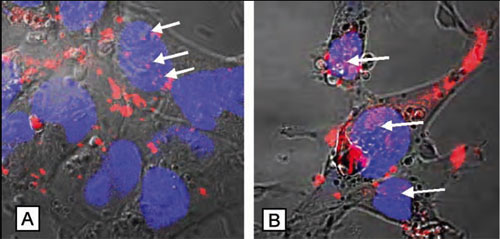| Posted: Jun 22, 2007 | |
A new type of nanoparticle to kill cancer cells |
|
| (Nanowerk Spotlight) In chemotherapy doctors are using a carpet bombing approach to destroy cancer cells: the patient is pumped full of cytotoxic drugs, that go everywhere in the body, with the hope that enough of the drugs reach the cancer cells and target their nuclear DNA to damage it or destroy the cell. | |
| Not only do chemotherapeutic techniques have a range of often serious side effects, mainly affecting all the fast-dividing cells of the body, it also has been shown that often less than 1% of the administered drug molecules enter tumor cells and bind to the nuclear DNA. Another complication is drug resistance of cancer cells. This actually is one of the main causes of failure in the treatment of cancer. | |
| Dividing cancer cells acquire genetic changes at a high rate, which means that the cells in a tumor that are resistant to a particular drug will survive and multiply. The result is the re-growth of a tumor that is not sensitive to the original drug. Cancer researchers are looking to nanoparticles as a drug carrier capable of localizing and directly releasing drugs into the cell nucleus, thereby circumventing the multidrug-resistance and intracellular drug-resistance mechanisms to effectively deliver drugs to the vicinity of DNA, leading to a high therapeutic efficacy. | |
| Scientists now have developed nanoparticles capable of localizing into the nucleus, giving hope to a much more effective cancer chemotherapy that allows to pinpoint individual cells. | |
| "There is a great need for carriers that can carry bioactive agents into the cell nucleus for drug as well as gene delivery" Dr. Youqing Shen explains to Nanowerk. "Because cancer cells have many intracellular mechanisms to limit drug molecules' access to the nucleus the direct delivery of the drug into the nucleus would circumvent these drug-resistance mechanisms. In gene therapy, the delivered gene must be in the nucleus for its transcription. However, in general, nanoparticles mainly localize in the cytosol (or extranucleus). So nanoparticles capable of localizing into the nucleus are urgently needed for cancer therapy." | |
| Shen is an Associate Professor of Chemical and Petroleum Engineering at the University of Wyoming. Together with colleagues from the university he developed a novel approach to fabricating nuclear localization nanoparticles. The key to their technique is a pH-triggered charge reversal. | |
| "We have demonstrated nanoparticles with a negative-to-positive charge-reversal outer layer (made of polyethyleneimine, or PEI) triggered by the solid tumor extracellular or the lysosomal acidity for nuclear drug delivery" says Shen. | |
 |
|
| Nuclear localization of TCRNs/PKH26 observed by confocal scanning laser microscopy after being cultured with SKOV-3 (ovarian cancer) cells for 12 h (A) or 24 h (B) at 37°C. The nuclei were stained with DRAQ5 (blue). PKH26 were assigned to red. Pink spots shown by the arrows correspond to TCRNs/PKH26 colocalized in the nuclei. Original magnification: 63x; the nuclear localizing efficiency was estimated by counting the cells with nuclear TCRNs/PKH26, of which 44% contained the TCRNs in their nuclei. (Reprinted with permission from Wiley) | |
| PEI is widely used in gene delivery and it was found that it can localize in the nucleus. The scientists hypothesized that nanoparticles functionalized with PEI may also be able to localize into the nucleus. "However" says Shen, "positively charged particles or polymers cannot be directly used in the body because the body's immune system would clear them out from the bloodstream very quickly. Our charge-reversal technique makes it possible for the PEI-functionalized nanoparticles to be used in the body: They are negatively charged and thus do not interact with the blood components. But once in the solid tumor or tumor cells they regenerate as PEI-functionalized nanoparticles for nuclear localization." | |
| Naming them "targeted charge-reversal nanoparticles" (TCRNs), the researchers loaded their nanoparticles with doxorubicin (DOX), an anticancer drug used in chemotherapy. In their experiments they found that the percentage of DOX-positive cells cultured with TCRNs/DOX was significantly higher than that cultured with free DOX under the same conditions at pH 7.4 (the average body pH). | |
| "Our findings suggest that the TCRNs could efficiently cross the cell membrane, escape from the lysosomes, and localize and deliver DOX in the nucleus to result in a greater cytotoxicity" says Shen. "This is the first type of nanoparticles capable of localizing into the nucleus. This type of nanoparticles and the charge-reversal techniques will also be useful in gene delivery." | |
| Because PEI is not as effective as nuclear localization signals (peptides) to direct nuclear localization, Shen and his colleagues are working on the use of peptides to functionalize the nanoparticles for more effective nuclear localization. He cautions, though, that the biggest challenge, as with other drug delivery carriers, is how to minimize the sequestration by the liver. | |
| These findings have been reported in a recent paper in Angewandte Chemie ("Targeted Charge-Reversal Nanoparticles for Nuclear Drug Delivery"). | |
 By
Michael
Berger
– Michael is author of three books by the Royal Society of Chemistry:
Nano-Society: Pushing the Boundaries of Technology,
Nanotechnology: The Future is Tiny, and
Nanoengineering: The Skills and Tools Making Technology Invisible
Copyright ©
Nanowerk LLC
By
Michael
Berger
– Michael is author of three books by the Royal Society of Chemistry:
Nano-Society: Pushing the Boundaries of Technology,
Nanotechnology: The Future is Tiny, and
Nanoengineering: The Skills and Tools Making Technology Invisible
Copyright ©
Nanowerk LLC
|
Become a Spotlight guest author! Join our large and growing group of guest contributors. Have you just published a scientific paper or have other exciting developments to share with the nanotechnology community? Here is how to publish on nanowerk.com.
